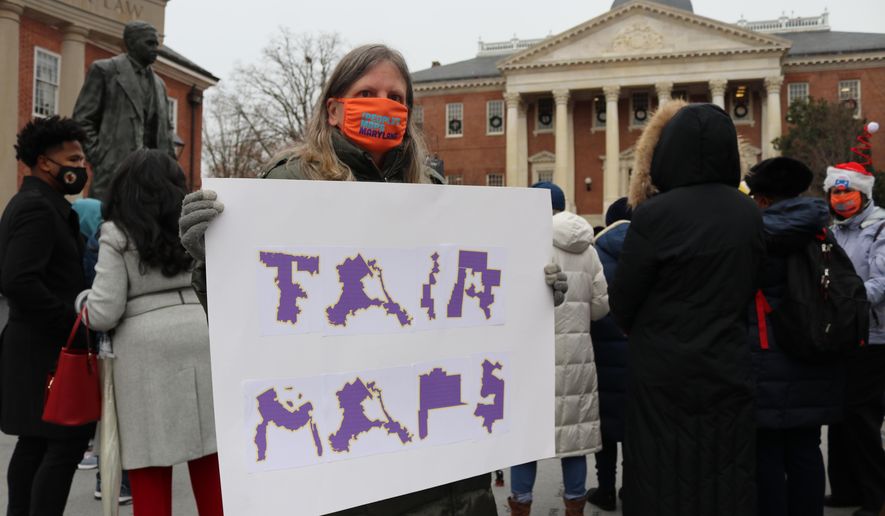ANNAPOLIS, Md. — The Maryland General Assembly approved a new congressional map on Wednesday, sending new Democratic-backed district boundaries for the state’s eight U.S. House districts to Republican Gov. Larry Hogan.
The governor, who submitted a proposal developed by a commission whose members he appointed, has said he will veto a map he believes is unfair.
Democrats, who have a supermajority in both chambers of the legislature and control redistricting in the state, say it’s an improvement on the current map - with districts that are more compact, contiguous and protective of the demographics of the state.
Republicans, however, say it remains unfairly drawn to favor Democrats and makes the state’s only Republican congressman vulnerable to losing his seat.
In a state where Democrats outnumber Republicans 2-1, Democrats currently hold a 7-1 advantage over the GOP in the state’s U.S. House delegation.
Outside the Maryland State House, supporters of redistricting reform rallied for a change in how the map is drawn. They called for an open application process for citizens to serve on a redistricting commission whose members would be chosen by someone who is not a politician.
“We still don’t have the process that we want, a fair open process that is done by a large broad range of citizens, not elected officials, and that is appointed by a neutral party,” said Nancy Soreng, who is co-president of the League of Women Voters of Maryland.
Politicians across the U.S. this year have been gerrymandering - drawing districts that either pack voters of the opposing party into a few districts or split them among multiple ones to dilute their influence. Republicans have done so in such states as Georgia and Texas and Democrats have done it in Illinois and Oregon.
Republicans dominated redistricting last decade, helping them build a greater political advantage in more states than either party had in the past 50 years.
Maryland Democrats say nonpartisan redistricting reform should come at the national level.
“I think we’ve developed a map that’s fair,” said Sen. Ron Young, a Frederick County Democrat. “Could it be better? Probably. Could it be worse? Easily. But who and what we send to Congress matters. If we give away seats while other states are taking them, my people that I care about aren’t being represented in Washington.”
Sen. Mary Beth Carozza, an Eastern Shore Republican, described the map favored by Democrats as one “where you see a dominance that will really affect the representation of the Eastern Shore.” She said lawmakers were moving ahead ”with a partisan map” and urged them to support the governor’s proposal.
“Marylanders have made clear that they do not want gerrymandered maps, and what’s disappointing and frustrating going through this process is that we have the opportunity this week in this Maryland General Assembly to break the cycle of gerrymandered maps,” Carozza said.
Senators rejected an amendment that would have substituted the governor’s proposal. Instead, they moved forward with a map approved by a commission with six legislators: four Democrats including House Speaker Adrienne Jones and Senate President Bill Ferguson, who supported the map, and two Republicans, Senate Minority Leader Bryan Simonaire and House Minority Leader Jason Buckel, who opposed it.
Hogan’s proposal was created by a panel of citizens he appointed that included three Democrats, three Republicans and three independents. He has described it as an effort to take politicians out of the business of drawing legislative districts, but Democrats have been quick to point out that the governor appointed its members.
Democrats hold the three-fifths majority in both chambers of the legislature that they would need to override a veto. The Senate voted 32-15 for the map on Wednesday, three more votes than the 29 they need to override a veto. The House approved it 97-42, 12 votes more than the 85 needed to override a veto.
Some of the most closely watched changes affect the 1st Congressional District, which includes the Eastern Shore and is now represented by Republican Rep. Andy Harris. The change to what is now a strongly Republican district would add enough registered Democrats to outnumber Republicans, though the district would still be competitive.
Almost as soon as the map was approved by the legislature, a grassroots organization called Fair Maps Maryland pledged to take aggressive legal action against it.




Please read our comment policy before commenting.